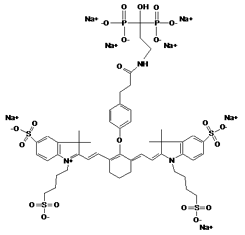
| Home > Projects/Technology > Contrast Agents |

Pam78 contrast agent (Zaheer et al., |
The Frangioni Laboratory is invested heavily in 800 nm near-infrared (NIR) fluorescent contrast agent chemistry. We have developed robust methods for the preparation of heptamethine indocyanine NIR fluorophores conjugated to small molecules, peptides, and proteins, and continue to develop disease-specific contrast agents for optical imaging.
In addition to organic NIR fluorophores, a currently funded project focuses on the development of NIR quantum dots (fluorescent semiconductor nanocrystals) for tumor-targeting and cancer-imaging applications. This work is a major collaboration between the Frangioni Laboratory at the BIDMC and the Bawendi Laboratory at MIT. |
 |
SPECT is a commonly used nuclear medicine technique that provides clinicians with relatively high sensitivity disease detection. We have developed novel chemical processes to convert readily available and expensive sodium pertechnetate to a chemically-pure N-hydroxysuccinimide (NHS)-ester derivative. This derivative is produced in organic solvent, without the need for any high-performance liquid chromatography (HPLC), and can be used to label any small molecule, peptide, or protein, thus creating the next generation of SPECT contrast agents. |
 |
We have developed a robust chemical process for the conversion of readily available and relatively inexpensive 18FDG to a chemically pure, NHS-ester intermediate. This intermediate can be used to label small molecules, peptides, or proteins with F-18, thus creating the next generation of PET contrast agents. |
 |
We are developing pre-labeling and post-labeling methods for the conjugation of lanthanide-labeled DOTA, and DOTA derivatives, to small molecules, peptides, and proteins. These conjugates could potentially produce the next generation of disease-targeted contrast agents for magnetic resonance imaging. |

